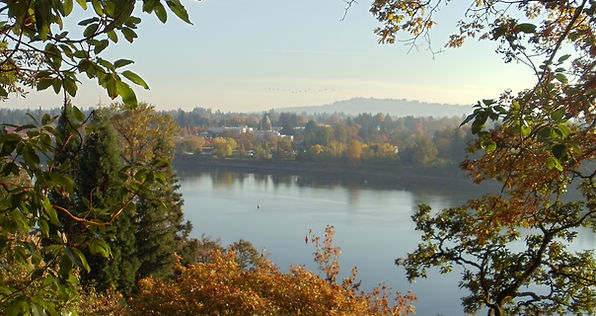
West Willamette Restoration Partnership
Connecting Portland's Urban Forest Project
This restoration project's goals are to preserve and restore wildlife habitat in an essential part of the Westside Wildlife Corridor around Marquam Nature Park and Terwilliger Parkway in support of larger conservation inititives through invasive species control
and focused restoration activities.

Project Updates
Connecting Portland’s Urban Forest project builds off of 20+ years of community efforts:
-
To restore and connect wildlife habitat and protect local streams,
-
increase awareness about the importance of natural areas,
-
improve access to nature for the community;
-
and to support local stewardship of our urban forest.
The project is sponsored by the West Willamette Restoration Partnership which is a coalition of organizations including Portland Parks & Recreation (a complete list of partners is listed on the bottom of the page). The project includes work in Marquam Nature Park, Terwilliger Parkway, Keller Woods, and adjacent private property, including the forested areas managed by Oregon Health & Science University. The goal of the project is to restore the health of 85 acres of forest in these important natural areas in the next three years.
Threat
A healthy ecological system thrives from a diversity of native plants and animals. Invasive plants kill trees and hurt wildlife, reducing diversity. Invasive plants and trees—English ivy, English holly, laurel and others—while present throughout most of Marquam Nature Park and Terwilliger Parkway, can be controlled if we address this issue comprehensively.
Opportunity
Community partners have made a substantial amount of effort to improve these natural areas. This project will help partners connect their restoration project areas to create a more comprehensive effort, install educational signage, and promote stewardship to showcase community investment. There are two techniques available to restore habitat through invasive species removal: manual removal and spray treatment. Both these tools will be used to support this restoration effort.
-
Manual Removal: Hand removal techniques will be utilized in areas with adequate volunteer access and along trails.
-
Selective Spray Treatment: Starting in late summer, invasive species in the most challenging terrain within the parks will be treated. Professional treatments are timed to ensure greater effectiveness and avoid impacts to ground nesting birds. All work will be guided by PP&R’s Integrated Pest Management (IPM) strategy—a nationally recognized program utilizing best practices for invasive plant management.
Frequently Asked Questions
Will the spray treatment put me, my kids or my dog at risk?
-
The methods we use are designed to protect park users. The treatment targets plants and has low toxicity to humans and animals. The materials break down relatively quickly in the environment. For more information, go to the National Pesticide Information Center: www.npic.orst.edu/
Is it safe to walk through the treatment area?
-
Trails will remain open during treatments. All treatment will occur off-trail in areas not typically accessed by the public. As in all natural areas, park users need to remain on the trail and keep pets on the trail at all times.
What is the spray treatment?
-
An IPM program-approved mix of low-concentration glyphosate and triclopyr with an added surfactant to help the solution penetrate targeted plants. A blue dye is added for visibility. The material is applied by state-licensed herbicide applicators doing selective spot treatment. These chemicals have been carefully scrutinized through decades of research to understand how they might be safely utilized as a tool for controlling invasive plants.
What will the forest look like after treatment?
-
In 1-2 months, you will begin to see invasive plants wither and die which will leave some brown and bare patches. The death of these plants will allow space for native vegetation such as trillium and other woodland wildflowers. We can expect to see more native plants by the following spring (2017). In heavily infested areas, revegetation through planting will be necessary.
Who is working on this project?
-
The West Willamette Restoration Partnership (WWRP) works to conserve and enhance the forests and natural areas of southwest Portland through an active coalition of engaged volunteers, community groups, landowners, and organizations. Project partners include City Bureau of Environmental Services and Portland Parks & Recreation, Columbia Land Trust, West Multnomah Soil and Water Conservation District, Friends of Marquam Nature Park and Friends of Terwilliger with support from the Homestead Neighborhood Association, SW Watershed Resource Center, and Oregon Health & Science University.
Why can’t all the invasive plants be removed by hand?
-
It is not realistic to accomplish the scale of removal we need by hand. Hand-removal works well in areas that are easily accessible with minimal slopes. Community volunteers are working on specific areas in both parks.
What is Integrated Pest Management (IPM)?
-
IPM is a tool that helps us determine the best way to manage a site. IPM considers a number of factors including: cost, site appropriateness,effectiveness and risk to people, property and the environment. Portland Parks & Recreation’s (PP&R) IPM Program was the first Parks Bureau in the nation to receive Salmon-Safe certification and is considered a nation-wide model.
How can I support this effort?
1. Keep your dog on leash at all times
2. Stay on trail
3. Volunteer to participate in a stewardship event with Portland Parks & Recreation: www.portlandoregon.gov/parks/stewardship
Questions about this project can be addressed by contacting SW Natural Resource Ecologist, Janelle St. Pierre at janelle.st.pierre@portlandoregon.gov or 503-307-3426.

Connecting Portland's Urban Forest Project Treatment Areas
Connecting Portland's Urban Forest is a collaborative project with diverse stakeholders bringing together restoration, stewardship and interactive learning across public and private properties of habitat in the Westside Wildlife Corridor.
Thank you to our Fiscal Partners in support of our partnership who have made this project possible:
Thank you to additional project partners: